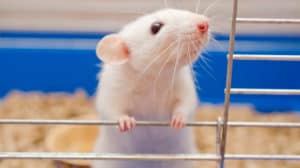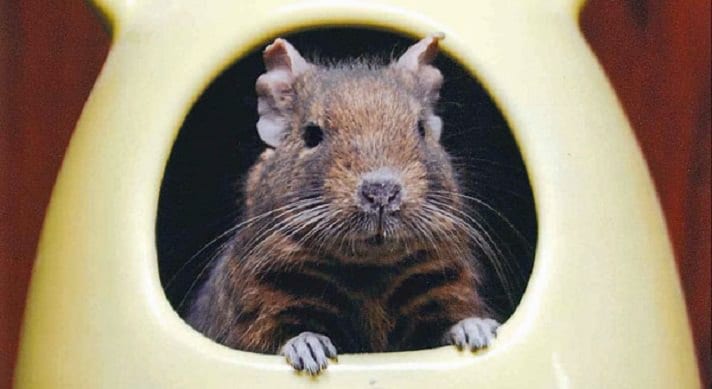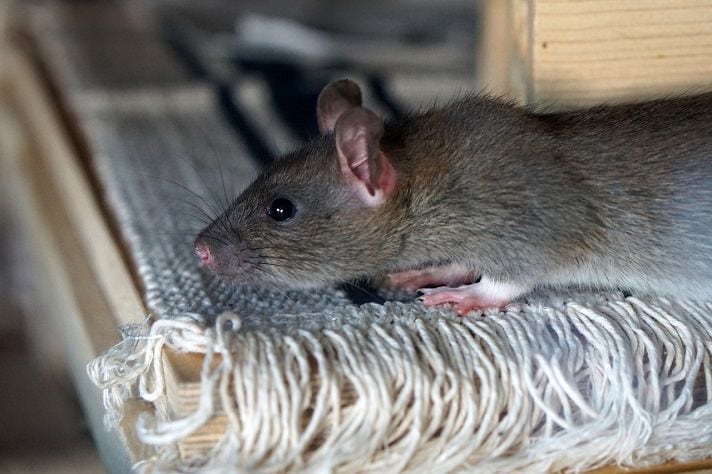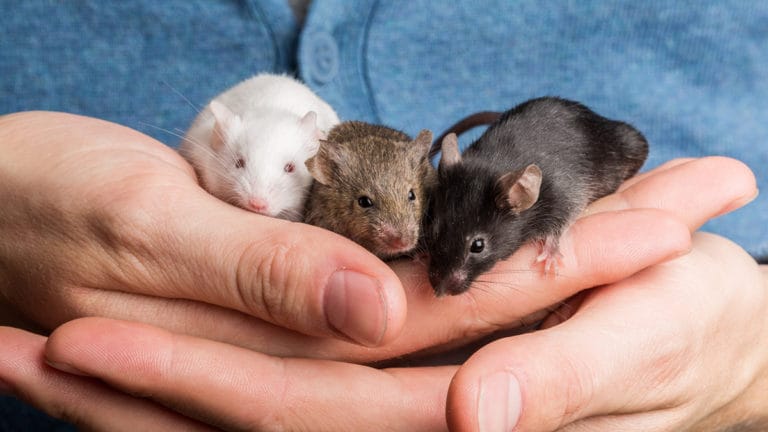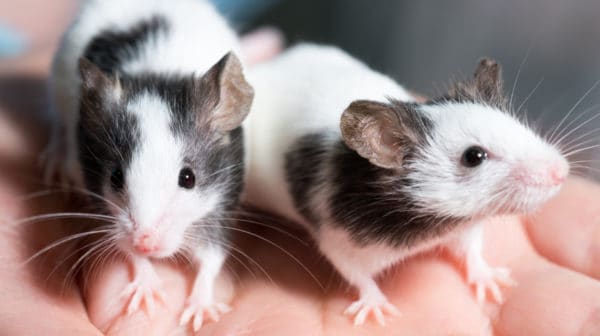Pet mice spend the majority of their lives within their enclosure or home-cage. Not surprisingly, the quality of this environment has a huge impact on the physical and psychological welfare of mice.
True environmental enrichment provides stimulation and opportunities for mice to perform natural or species-specific behaviors. These include socializing, grooming, exploring, foraging, climbing, hiding, gnawing, manipulating objects, nesting and digging.
It follows then that the optimum environment for mice is one that allows and facilitates these behaviors. Studies show that environmental enrichment can lower stress hormones, boost immunity and improve brain function in mice. The good news is that you can do plenty of things to enrich your pets’ environment.
Mice Enjoy Mouse Companions
Mice are social creatures and prefer, where possible, to be housed with other mice. Mice that live together will play together, groom one another and sleep together. Keeping two mice is no more trouble, but twice the fun — watching mice interact with each other can provide hours of entertainment.
Think carefully about social arrangements first. Male and female mice housed together will inevitably reproduce, yielding potentially hundreds of mice within a matter of months.
If you do not intend to breed mice, pairs or trios of females are probably ideal. Mice get along best when they are from the same litter.
Male mice are much more likely to fight than females. Males generally do not like unfamiliar males and will fight an “intruder” — sometimes to the death. Even well acquainted males that are separated for a short period of time (as may occur during cage cleaning) may turn on one another. If males are housed together, placing some used nesting material into the cleaned cage might reduce (but not eliminate) aggression.
Scientific studies suggest that where a mouse must be housed alone (for example an extremely aggressive mouse), provision of other forms of environmental enrichment might reduce the stress of isolation.
Mice Enjoy A Place Of Their Own
Solid shelters and dividers within the cage allow mice a place to retreat from the outside world, and provide a structure that mice can climb, chew and interact with. Given the opportunity, many mice prefer to build their nest within an in-cage shelter.
Studies show that mice prefer small, angular shelters. When offered a shelter with one open side or two, the majority of mice choose a box with one open side and typically sleep with their head toward that side.
While many mice retreat into tunnels or shelters when the cage is opened, these structures can actually make it easier to catch and handle mice, because the shelter can be gently picked up, which allows the mouse to crawl out onto your hand.
Mice appreciate shelters with a flat roof rather than a steeply angled roof. Flat roofs allow mice to climb on top and use the structure as a platform.
Dividers and shelters may also reduce aggressive encounters by giving mice a space to retreat from one another if tensions rise. Shelters and dividers that are easily dismantled are much easier for mouse owners to clean.
Mice Enjoy Nesting And Bedding Material
Mice are highly motivated to build nests, regardless of their gender or reproductive status. In one study, mice provided with nesting material spent up to one fifth of their time manipulating that material. Nests enable mice to control the temperature in their immediate environment and, together with shelters, allow refuge from light and external disturbances.
Nesting material should be light and non-toxic to mice. It can be purchased, however mice are resourceful and will build nests with grass hay (such as timothy hay), shredded paper, tissues or paper towels. Mice appear to enjoy shredding paper and tissue as part of the nesting process, so let them do the work by providing whole tissues rather than shredding them yourself if you provide these.
Unlike nesting material, which is typically used to build a discrete nest in one part of the cage, mice also like a deep bedding or substrate in which to dig and burrow. When digging, mice alternate between digging with their forepaws and kicking back with their hind paws. They can become absorbed in this activity for lengthy periods.
Ideally, bedding should be at least between a half-inch and 1 inch deep to permit digging. Bedding should be non-toxic, absorbent and free of parasites. Cedar and nonkiln-dried pine shavings should be avoided as these contain toxic oils (phenols) that some studies indicate might harm mice.
Bedding should be replaced regularly to avoid a build up of moisture and ammonia from mouse urine, as this reduces air quality within the enclosure.
Uses For Food, Treats And Chew Toys
Food can be used to encourage exploring and foraging activity by scattering or hiding morsels around the enclosure so that your mice have to sniff them out. Food can also be hidden inside toys such as tunnels. Any food that is not eaten should be removed eventually to ensure the enclosure is kept clean.
Mice have a highly sensitive sense of smell and take a great interest in treats that smell different than their ordinary diet. Treats can be used in taming mice by feeding them by hand. Alternatively, treats can be used in training as a reward for performing a desired task. You can purchase mouse treats from the pet store. Alternatively, a piece of breakfast cereal, grains, biscuit crumbs or a small piece of dog food can be used as a treat — but must only be fed in small amounts.
Non-toxic chews not only keep mice busy gnawing, but also help wear down their continuously growing teeth. These can be purchased from any good pet store.
How-To’s Of Mouse Interaction And Handling
As prey animals, mice tend to be frightened of people, but with patience and regular handling many can be tamed and learn to enjoy interaction with humans.
The key is to be slow and gentle in your approach. It may be easier to allow your mouse to retreat into a shelter. This way you can pick up the shelter and allow the mouse to crawl from the shelter onto your hand.
Hand-feeding your mouse can help the mouse to associate handling with a positive food reward. You may even be able to encourage your mouse to perform a trick (climbing a ladder) by offering a food reward.
Regular short periods of handling (10 to 20 minutes per day) are ideal. As with people, some mice like interaction with humans more than others. No matter how good an owner you are, some mice will not become accustomed to handling. Other forms of enrichment may be more appropriate for these individuals.
Mice Gotta Exercise
Mice spend large proportions of their time using a running wheel where one is provided, particularly at night (all the more reason to ensure the wheel doesn’t make loud, squeaking noises!). Solid wheels are superior to those with wire bars as the tail and feet of the mouse don’t become trapped. They do, however, require regular cleaning. Some mice will use the wheel as an additional shelter by digging below it. Ensure that the wheel does not get jammed with piles of bedding underneath it.
If you purchase a wheel that is suspended from the top of the cage, ensure that your mice can reach it.
Exercise balls provide a mode of exploring the outside world, but they must only be used under supervision. Do not allow other pets such as cats to interact with the ball, as this can be highly stressful for mice. Always keep the ball away from stairs or other hazards. Sessions in the ball should be limited to no more than 10 minutes, as mice can overheat and might require access to water.
Mouse Toys – Keep ‘Em Coming!
Toys include items that mice can climb (ropes, ladders, hammocks) and items that can be pushed, carried or otherwise manipulated (cubes, balls, blocks, bells). Some household items can be adapted for use as toys, but you need to ensure they are non-toxic and safe for your mouse to use.
Mice show a great deal of interest in toys, particularly when they are introduced into a cage. Because of this novelty factor, it is best to introduce one toy at a time on a rotating basis (for example, once a week).
Excerpt from the former annual magazine Critters USA, 2009 issue, with permission from its publisher, Lumina Media.
By: Anne Fawcett BA(HONS), BSC(VET)(HONS), BVSC(HONS), CMAVA
Featured Image: Kirill Kurashov/Shutterstock.com
Share:
